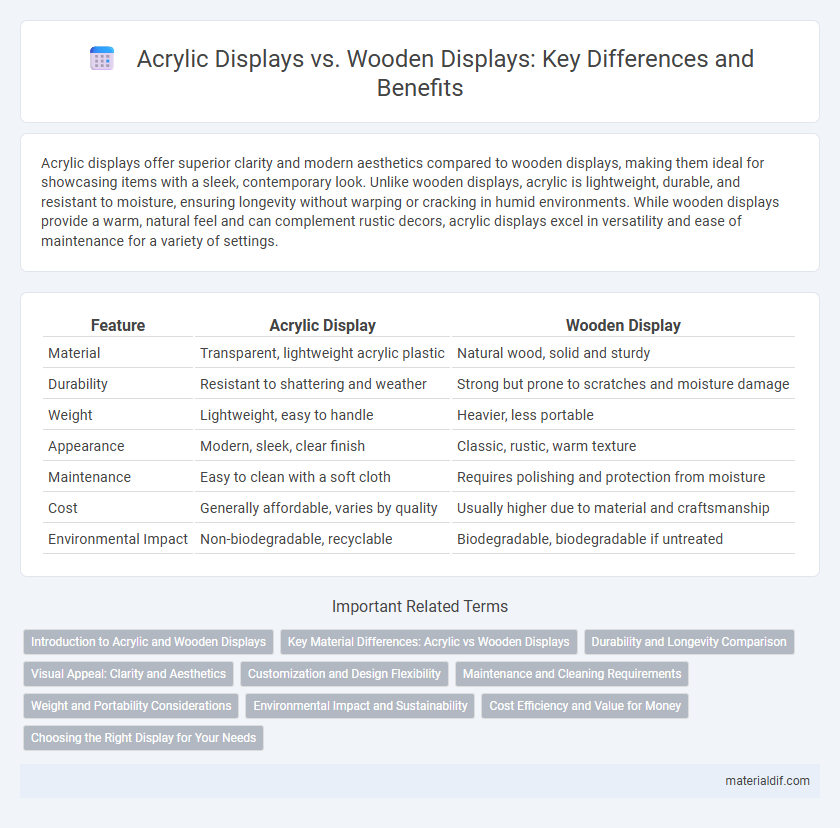Acrylic displays offer superior clarity and modern aesthetics compared to wooden displays, making them ideal for showcasing items with a sleek, contemporary look. Unlike wooden displays, acrylic is lightweight, durable, and resistant to moisture, ensuring longevity without warping or cracking in humid environments. While wooden displays provide a warm, natural feel and can complement rustic decors, acrylic displays excel in versatility and ease of maintenance for a variety of settings.
Table of Comparison
| Feature | Acrylic Display | Wooden Display |
|---|---|---|
| Material | Transparent, lightweight acrylic plastic | Natural wood, solid and sturdy |
| Durability | Resistant to shattering and weather | Strong but prone to scratches and moisture damage |
| Weight | Lightweight, easy to handle | Heavier, less portable |
| Appearance | Modern, sleek, clear finish | Classic, rustic, warm texture |
| Maintenance | Easy to clean with a soft cloth | Requires polishing and protection from moisture |
| Cost | Generally affordable, varies by quality | Usually higher due to material and craftsmanship |
| Environmental Impact | Non-biodegradable, recyclable | Biodegradable, biodegradable if untreated |
Introduction to Acrylic and Wooden Displays
Acrylic displays offer a modern, transparent, and lightweight option ideal for showcasing products with enhanced visibility and durability. Wooden displays provide a classic, sturdy, and natural aesthetic that adds warmth and texture to retail or exhibition environments. Both materials serve distinct purposes, with acrylic excelling in sleek, contemporary presentations and wood in creating a rustic, organic ambiance.
Key Material Differences: Acrylic vs Wooden Displays
Acrylic displays offer enhanced clarity, durability, and weather resistance compared to wooden displays, making them ideal for modern retail and exhibition environments. Wooden displays provide a natural, rustic aesthetic with sturdiness but are susceptible to moisture damage and require more maintenance than acrylic. The choice between acrylic and wood depends on factors like desired visual appeal, environmental conditions, and longevity needs.
Durability and Longevity Comparison
Acrylic displays offer superior durability compared to wooden displays due to their resistance to moisture, impact, and UV exposure, which prevents warping, cracking, or fading over time. Wooden displays, while aesthetically pleasing, are prone to damage from humidity and physical wear, reducing their longevity in high-traffic environments. The impact-resistant, non-porous nature of acrylic ensures a longer lifespan and consistent appearance, making it a more durable choice for display purposes.
Visual Appeal: Clarity and Aesthetics
Acrylic displays offer superior clarity and a sleek, modern aesthetic due to their transparent, glossy surface that enhances product visibility and attracts attention. Wooden displays provide a warm, rustic appeal with natural textures and grains that create a tactile, organic look but may obscure details compared to acrylic's crystal-clear finish. The choice between acrylic and wooden displays depends on the desired blend of contemporary elegance versus traditional charm in visual presentation.
Customization and Design Flexibility
Acrylic displays offer superior customization and design flexibility compared to wooden displays, allowing for precise cutting, molding, and vibrant color options that cater to specific branding needs and intricate shapes. The lightweight nature of acrylic facilitates easy integration of LED lighting and transparent elements, enhancing visual appeal and product visibility. Wooden displays, while sturdy and natural in appearance, have limited design adaptability and often require manual craftsmanship, restricting intricate custom designs and rapid prototyping.
Maintenance and Cleaning Requirements
Acrylic displays require minimal maintenance, as they can be easily cleaned with a soft cloth and mild soap, resisting dust and moisture effectively. Wooden displays demand more frequent upkeep, including polishing and protection from humidity to prevent warping or cracking. The smooth, non-porous surface of acrylic makes it more hygienic and less prone to stains compared to porous wood materials.
Weight and Portability Considerations
Acrylic displays are significantly lighter than wooden displays, enhancing portability for easy transport and setup in various locations. The lightweight nature of acrylic reduces shipping costs and simplifies handling during events or retail changes. Wooden displays, while sturdy, tend to be bulkier and heavier, limiting mobility and increasing effort in transportation.
Environmental Impact and Sustainability
Acrylic displays, made from non-biodegradable petroleum-based plastics, contribute to long-lasting environmental pollution and are challenging to recycle, impacting sustainability negatively. Wooden displays, sourced from renewable timber, offer better biodegradability and lower carbon footprint, especially when derived from FSC-certified forests promoting responsible forestry management. Choosing wooden displays supports a circular economy through natural decomposition and sustainable resource use, whereas acrylic displays often accumulate as persistent plastic waste.
Cost Efficiency and Value for Money
Acrylic displays offer higher cost efficiency compared to wooden displays due to their lower manufacturing and maintenance expenses, making them ideal for budget-conscious businesses. Acrylic's lightweight and durable properties reduce shipping and handling costs while providing clear visibility that enhances product presentation. Wooden displays, though often perceived as more premium, typically involve higher upfront costs and maintenance, delivering less value for money in fast-paced retail environments.
Choosing the Right Display for Your Needs
Acrylic displays offer lightweight, shatter-resistant properties with excellent clarity, making them ideal for showcasing products in modern retail environments where visibility and durability are crucial. Wooden displays provide a natural, rustic aesthetic with sturdy construction, best suited for artisanal or eco-friendly branding that emphasizes sustainability and warmth. Selecting between acrylic and wooden displays depends on factors such as the desired visual appeal, durability requirements, and the target audience's preferences.
Acrylic Display vs Wooden Display Infographic

 materialdif.com
materialdif.com